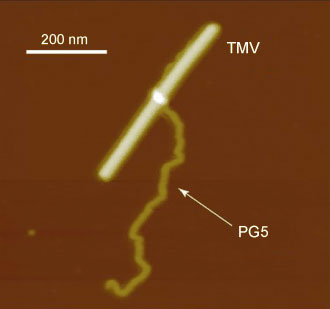| Jan 04, 2011 |
From molecule to object - Largest synthetic structure with molecular precision
|
|
(Nanowerk News) Organic Chemists have always been trying to imitate biology. Although it is possible to make many molecules that imitate biomolecules in terms of structure and function, it remains a challenge to attain the size and form of large biomolecules. An international team led by A. Dieter Schlüter at the ETH Zurich (Switzerland) has now introduced a branched polymer that resembles the tobacco mosaic virus in size and cylindrical form. As the researchers outline in the journal Angewandte Chemie ("The Largest Synthetic Structure with Molecular Precision: Towards a Molecular Object"), this is the largest synthetic macromolecule with defined shape and atomic structure reported to date.
|
 |
| Pushing the limits: A 200x106 Da structurally defined, linear macromolecule (PG5) has a molar mass, cross-section dimension, and cylindrical shape that are comparable to some naturally occurring objects, such as amyloid fibrils or certain plant viruses. The macromolecule is resistant against flattening out on a surface; the picture shows PG5 embracing the tobacco mosaic virus (TMV).
|
|
Previously, the largest reported synthetic structures with a defined atomic structure were polystyrene polymers with a molecular mass of about 40 million Daltons. However, this value corresponds to a small fraction of the mass of large DNA molecules. Formation of a large synthetic molecule that also has a defined form is much more difficult. For biologists, however, it is routine. Even the simplest organism has a well-defined form, such as the rod-shaped tobacco mosaic virus. For chemists it is a model: a massive molecular ensemble with perfect control over its chemical structure, function, size, and molecular form.
|
|
Schlüter and co-workers have now presented a branched polymer that approximates the size and form of the tobacco mosaic virus. Their complex synthesis, which requires 170,000 bond-forming reactions in a single molecule, led to a structurally defined, linear macromolecule with a diameter of about 10 nm and a molecular weight of 200 million Daltons. It thus has a molar mass, cross section, and cylindrical form comparable to the tobacco mosaic virus.
|
|
The new macromolecule is a dendronized polymer: it consists of a linear backbone with highly and regularly branched side chains. "This is the biggest synthetic macromolecule with a defined chemical structure and defined form to date," according to Schlüter. "Our experiment is a first step toward the synthesis of molecular objects." A structure is considered to be an object if it keeps its form regardless of its environment, when its interior can be distinguished from the outer environment, and when there is a clear boundary between the two. There are many synthetic nano-objects, however these are not single molecules, but are aggregates of several or many individual molecules.
|

